

Mysterious Underwater ‘Crop Circle’ Art Discovered Off the Coast of Japan. According to the National Oceanic and Atmospheric Administration less than five percent of the world’s oceans have been explored, meaning that 95% of what lies deep underwater on Earth has yet to be seen by human eyes.
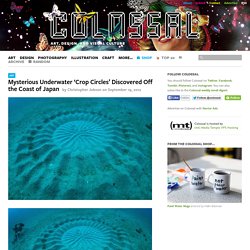
One person who has dedicated his life to uncovering the mysteries of the deep is Japanese photographer Yoji Ookata who obtained his scuba license at the age of 21 and has since spent the last 50 years exploring and documenting his discoveries off the coast of Japan. Recently while on a dive near Amami Oshima at the southern tip of the country, Ookata spotted something he had never encountered before: rippling geometric sand patterns nearly six feet in diameter almost 80 feet below sea level.
Edith Widder: The weird, wonderful world of bioluminescence. Endangered. Panda blood compound 6x more powerful than current antibiotics. In what could be either very good news or very bad news for our fluffy black and white friends, it's been discovered that panda blood contains an antibiotic compound that's vastly more powerful than anything we've got right now.

Researchers at the Life Sciences College of Nanjing Agricultural University in China have extracted a compound called cathelicidin-AM from the blood of giant pandas. Cathelicidin-AM is what's called a gene-encoded antimicrobial peptide, a natural antibiotic that's produced by a panda's immune cells. Testing has shown that cathelicidin-AM can kill even drug resistant strains of bacteria and fungi, and it can do in one hour what conventional antibiotics can barely do in six, without causing nearly as much resistance.
Cathelicidin-AM could get turned into a drug, or it could get turned into a surface sanitizier. Sea Cucumber Poo May be Key to Saving Coral Reefs. Quinet/CC BY 2.0 With a name and shape more befitting of a salad-topping fruit than an ocean-faring animal, sea cucumbers are arguably one of the most striking species to roam the sea floor -- but their importance to the health of marine ecosystems is proving far more noteworthy than that unfortunate misnomer.
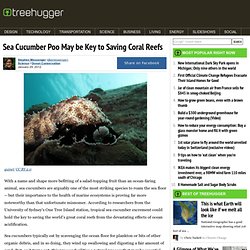
According to researchers from the University of Sydney's One Tree Island station, tropical sea cucumber excrement could hold the key to saving the world's great coral reefs from the devastating effects of ocean acidification. Sea cucumbers typically eat by scavenging the ocean floor for plankton or bits of other organic debris, and in so doing, they wind up swallowing and digesting a fair amount of sand. But, as it turns out, this process facilities a natural process that may be essential for preserving the health of coral by counteracting the pH level drops associated with ocean acidification. Meet Trogloraptor: America's Newest Cave Spider. California Academy of Sciences A cave-dwelling creature named Trogloraptor sounds like the villain of a B horror film, but it’s actually a newly discovered type of spider.
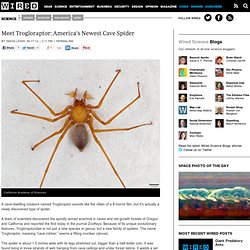
A team of scientists discovered the spindly armed arachnid in caves and old-growth forests of Oregon and California and reported the find today in the journal ZooKeys. Because of its unique evolutionary features, Trogloraptoridae is not just a new species or genus, but a new family of spiders. The name Trogloraptor, meaning “cave robber,” seems a fitting moniker (above). The spider is about 1.5 inches wide with its legs stretched out, bigger than a half-dollar coin. Help Oceanographers Comb the Ocean Floor From the Comfort of Your Screen. End-of-summer blues have you thinking of your next beach vacation?
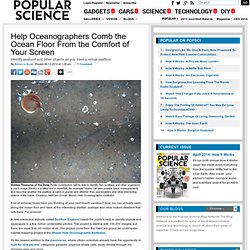
Now you can virtually swim along the ocean floor and stare at the interesting starfish, scallops and other bottom-dwellers that lurk there. For science! A new interactive website called Seafloor Explorer needs the public's help to identify objects and seascapes in a few million underwater photos. The project is starting with 100,000 images, but there are more than 40 million in all. The photos come from the HabCam group, an underwater habitat-mapping project at the Woods Hole Oceanographic Institution. It's the newest addition to the Zooniverse, where citizen scientists already have the opportunity to hunt for new planets, categorize galaxies, organize whale calls, study climate through old shipping logs, and more.
To participate, head over to SeafloorExplorer.org and create a login. First evidence for photosynthesis in insects. Pigments that can harvest the Sun's energy have a role in the metabolism of pea aphids.
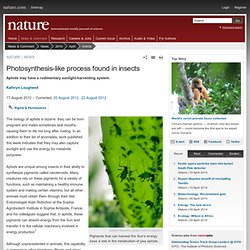
The biology of aphids is bizarre: they can be born pregnant and males sometimes lack mouths, causing them to die not long after mating. In an addition to their list of anomalies, work published this week indicates that they may also capture sunlight and use the energy for metabolic purposes. Aphids are unique among insects in their ability to synthesize pigments called carotenoids. Many creatures rely on these pigments for a variety of functions, such as maintaining a healthy immune system and making certain vitamins, but all other animals must obtain them through their diet.
Entomologist Alain Robichon at the Sophia Agrobiotech Institute in Sophia Antipolis, France, and his colleagues suggest that, in aphids, these pigments can absorb energy from the Sun and transfer it to the cellular machinery involved in energy production1. Unknown Artistic Insect Builds a White Picket Fence to Protect its Nest of Eggs. Earlier this summer while on vacation in Peru, graduate student Troy Alexander fell in love with the Amazon rainforest, and on his return asked an advisor at Georgia Tech if he could take a leave of absence and return to Peru as volunteer researcher.

Three weeks later, Alexander found himself on a plane heading back South America to begin work for the Tambopata Macaw Project which focuses on parrot biology and conservation. It was a decision that would lead to his potential discovery of a new species of life, or at least one so rare nobody has a clue what it is. While assisting with the project, Alexander stumbled onto fascinating structures attached to tree trunks, including a blue tarp that appeared to have been built by a spider or insect.